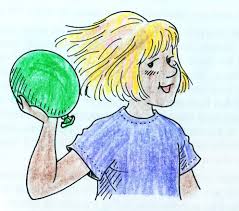A founding principle of the PIE program is that parents can be active participants in student classrooms, acting as 'Partners in Education.' Ms. Canevari enjoys working with parents who have a special area of expertise. She and the parent volunteer work together to develop unique lessons for her students. This year she has a student in her class whose mom, Dory Masefield, has a PHD in Physics and a Masters degree in Chemistry. Mrs. Masefield has presented several exciting lessons on energy to this very lucky 2-3 class. Read on to see what they have discovered!!
The class was introduced to Newton's first law of motion: an object at rest tends to stay at rest, and an object in motion tends to stay in motion with the same direction and speed. Mrs. Masefield illustrated the concept by placing an object on a skateboard. If the object and the skateboard accelerate together when the skateboard stops abruptly, the object flies forward. When she demonstrated accelerating the skateboard quickly the object fell backwards.

Like this!
She also illustrated the same principle by pulling a cloth out from under a jar...
Try it at home yourself- maybe?
Another classroom visit was planned for Mrs. Masefield to illustrate states of matter with ice. She explained to the young students that there are different levels of energy and heat in ice vs. water vs. gas. If you put a drop of food dye in a jar of warm water and another drop of food dye in cold water you can observe how quickly the dye mixes in the warm water on its own due to the higher energy of the molecules.
She also demonstrated how water moves through plants by putting food dye in a cup of water and then placing either celery or lettuce in the cup. The students eagerly watched how the food dye traveled up through the plant to the very tip. Cohesion and surface tension within the plants stem makes the plant suck up water- almost like drinking through a straw!
Next, Mrs. Masefield illustrated the presence of oxygen in air and chemical energy using a candle. She placed a small jar over a candle and the fire went out quickly because the oxygen was used up. When she placed the larger jar over the candle flame it lasted longer because the jar contained more oxygen.

The lesson that the kids enjoyed the most was a the lesson on electrical energy. Mrs. Masefield illustrated the lesson by taking a small balloon and rubbing it on her hair. She used small balloons and let the whole class try it. It was very funny to see some of the students an hour after the lesson still "wearing their balloons" in their hair! The lessons she presented to the students were all aimed at illustrating the presence of things we cannot see and the kids were amazed each time she came into the classroom.

The next several lessons Mrs. Canevari's 2-3 PIE class will participate in will be focused on ecosystems. Mrs. Masefield and another parent, Kathy Stevens, (who is also a Chemist!) will go outside with Mrs. Canevari and her class on Thursday afternoons each week to study the pond and woods on the Sanfordville school grounds. The students will hike the nature trail (there is a nature walk on the Sanfordville grounds), and observe the movement of energy through the ecosystem. Mrs. Masefield has taken a baseline temperature of the pond in two places and temperatures of the river in two places. The students will graph the temperatures each week to watch it change. They will also measure the buds and leaves on the trees and plants as they begin to grow and ID the tree species on the school grounds. The kids will definitely enjoy seeing the changes outside as the weather begins to warm up!

























